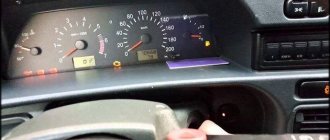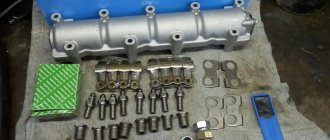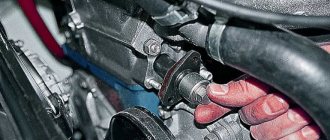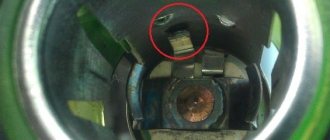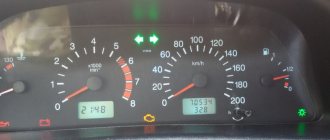Modern cars are packed with sensors like a Christmas turkey with apples. Moreover, all or almost all sensors are interdependent. If the speedometer on our Niva Chevrolet does not work, it may happen that the electronic control unit also receives incorrect impulses. And this affects engine performance , gasoline consumption, and power. A non-working speedometer is not just an inconvenience, it is a reason to look at the reasons and restore the system’s functionality.
The video shows how the speedometer on a Niva Chevrolet can “glitch”:
Niva Chevrolet speedometer does not work
Modern cars have a large number of sensors that correct the operation of the car. And they are all very strongly interconnected. If the Chevrolet Niva speedometer does not work, then there may be several reasons for this, ranging from the speed sensor to the electronic control unit. This, in turn, can lead to improper engine operation, increased fuel consumption and other problems. Therefore, a non-functioning speedometer is not only a problem with traffic control, but also a possible cause of major malfunctions. This means that it is urgent to diagnose the car.
In the Niva Chevrolet, the speedometer needle is driven not by a cable, as on old cars, but by an electronic control system, which is controlled by a magnetic sensor. The speedometer needle is an ammeter driven by the difference in current transmitted by the sensor.
If, as a result of diagnostics, a problem is identified with the instrument panel, then in most cases it may require a complete replacement, since it is non-repairable and its components are located on one board.
The speed sensor transmitting the impulse to the instrument panel is installed on the transfer case. These signals are transmitted to the ECU, where they are processed, engine parameters are read and transmitted to the instrument panel.
It is quite simple to determine problems in the operation of the speedometer: these are inflated indicators, for example, when a car shows clearly inflated speed indicators, the needle twitches during uniform movement or does not rise from the zero mark.
There are several main reasons that can affect the operation of the speedometer:
- Mechanical damage to the instrument panel
- Damage to wiring or contacts
- Short circuit
- Speed sensor failure
- ECU failure
Some problems can be determined by connecting an OBDII sensor to the panel
If problems with the speedometer are accompanied by a Check Engine error, then in this case the problem will be related to the ECU. By checking it with a sensor, you can most likely detect error 0500.
First, you should conduct a self-diagnosis of the instrument panel. To do this you need to follow a few simple steps:
- Turn off the ignition and hold down the button to reset the daily mileage
- Hold the button to turn on the ignition
- Release the button
- If the instrument panel is working properly, then the instrument arrows should rise to the maximum division and return to their original position.
If the speedometer needle does not move or there are malfunctions in their operation, then the problem is in the instrument panel. You should disconnect it and check the condition of the contact blocks. It is possible that during operation due to vibrations, the contacts in the block became disconnected from the common bundle to the instrument panel.
Pin 9 is used to connect the speedometer. In some cases, for example, when repairing an instrument panel, it may be installed skewed, which may subsequently affect the operation of the system.
If these steps do not help, then you need to check the contact block on the speed sensor. To do this, you need to install the car on an inspection hole or overpass. It is located at the bottom of the transfer case and water and reagents used to treat roads can get on it.
After this, you need to check the wires leading from it to the speed sensor. The wire may fray or suffer other mechanical damage. The car body carries a negative charge - mass. And if the wire sheath is damaged, a short circuit may occur.
It is also necessary to pay attention to its condition. It is often made not only in a metal case, but also in a plastic one, which encloses a core with a winding and a rotor. Depending on the rotation speed, the level of current generated and, accordingly, the position of the speedometer needle depend.
This element is not repairable, since it is enclosed in a solid body. Therefore, if malfunctions occur, it must be replaced. You can check its performance using a multimeter. Before doing this, you need to remove it:
- The terminals are disconnected from the sensor
- The sensor is unscrewed
- An inspection and assessment of its condition is carried out.
- There are three terminals suitable for the sensor: minus, plus and central pulse. When checking, the multimeter is connected with a negative probe to ground, and a positive one to the central connector
- A tube is placed on the sensor roller and the multimeter is switched to minimum measurement mode
- Using the tube, the sensor rotates, and if it is working properly, the multimeter should show deviations from the rest state.
If the multimeter does not show the operation of the element being measured, it means that it is faulty and requires replacement.
Purpose of the device
Therefore, the main function of the device is to read information about the movement of the vehicle. Indirect functions of the device include:
It is possible to drive a car without this part, but it is quite difficult.
- Mechanical or optoelectronic. It works by transmitting the number of revolutions of the box shaft using a cable.
- Electronic or cableless. Actually, that’s what we’ll be talking about.
Operating principle of the sensor
The essence of the effect (and operating principle) is the reading of electromagnetic pulses by a sensor, which are sent to the controller for subsequent processing. One kilometer of the vehicle's travel distance is equal to 6004 electronic pulses from the sensor. When the car moves faster, the frequency of pulse transmission increases. The controller, in turn, measures the intervals between each pulse and displays them on the speedometer in a form understandable to humans.
On a Niva Chevrolet car, the sensor is installed on the gearbox. Due to the rotation of the box shaft, electromagnetic pulses are generated inside the device.
Device malfunctions
- Open circuit;
- Oxidation of contacts;
- Violation of the integrity of conductor insulation;
- Damage to the integrity of the device or wear of internal mechanisms.
Checking the speed sensor for faults
First way. To carry out the test you will need a multimeter.
If such a process is observed, then the speed sensor is serviceable, and the cause should be looked for elsewhere.
- The front part of the car is raised with a jack so that one wheel is suspended.
- A multimeter is connected to the sensor terminals.
- The wheel rotates and the appearance of pulses is detected. If voltage is induced, then the device is in working order.
The device is replaced only if the exact cause of its failure is determined. So, first of all, you need to find where the product is attached and remove it. To do this, perform the following sequence of actions:
If the product does not unscrew, then it is strictly forbidden to pull it. It is necessary to lubricate the threaded connection with WD-40 liquid and wait until the corrosion wears off.
The sensor is being replaced with a new one. Its installation is carried out in the reverse order of removal.
After the replacement has been made, it is necessary to carry out the process of resetting the ECU error. Otherwise, the “Check Engine” will continue to light up on the instrument panel.
For your information! When purchasing a device, pay attention to the manufacturer, because most of them are produced in China. The quality of such materials is low, and the service life is directly proportional to the operating time of the car. The photo shows a domestic sensor with varnished contacts. Chinese production considers this action unnecessary, which is due to the low service life of the product.
The considered part on the car performs a function without which it is impossible to control the speed of movement of the transport mechanism. The first sign of product failure is the speedometer needle moving or its oscillating movements. This is an indication that the speed sensor will soon need to be replaced. Good luck finding faults and fixing them!
How to independently replace the speed sensor 2170/2118 on a car of the VAZ 2170 (Priora), VAZ 2190 (Granta), VAZ 2117 - 19 family.
When driving, the dashboard refuses to show the speedometer and odometer. The solution is to replace the speed sensor.
Why the Niva Chevrolet speedometer does not work: reasons and repairs
Modern cars are packed with sensors like a Christmas turkey with apples. Moreover, all or almost all sensors are interdependent. If the speedometer on our Niva Chevrolet does not work, it may happen that the electronic control unit also receives incorrect impulses. And this affects engine performance , gasoline consumption, and power. A non-working speedometer is not just an inconvenience, it is a reason to look at the reasons and restore the system’s functionality.
The video shows how the speedometer on a Niva Chevrolet can “glitch”:
Symptoms of a problem
Simply observing the car's behavior will help you understand that the speedometer sensor is not working. Typically the symptoms of a breakdown are factors.
- The speedometer needle jumps, jerks or does not respond. This is due to the complete failure of the device and the need for its immediate replacement.
- Increased fuel consumption. Part of the system is interfaced with the ECU, therefore, the remaining sensors will also act up.
- The speedometer is reporting incorrect data. If a motorist sees that the actual speed of the car differs significantly from the measured one, this is a sign of a device failure.
- 4. Separately, instability of idle speed should be considered. The device is also responsible for the operation of the motor at idle.
Reasons for a non-working speedometer: from simple to complex
In the Niva Chevrolet, the speedometer needle is driven not by a cable and a magnetic device, as in classic VAZs, but by electronics. The speedometer itself, like the rest of the instruments on the panel, are nothing more than voltmeters or ammeters with different scales.
The speedometer receives an electrical impulse, and the needle is driven by a simple stepper electric motor.
This is for information, because it is useless to poke into the speedometer itself, it is not repairable and if at least one element fails, you have to buy the entire instrument panel on the circuit board.
The speedometer receives an impulse from the speed sensor, and it is installed on the transfer case housing. These impulses are also monitored by the electronic engine control unit and, receiving them, draws its conclusions about the operating mode of the motor.
The signs of a non-working speedometer are quite clear - the needle either lies shamelessly, showing 160 at a speed of 20 km/h, or twitches, or falls dead to the zero mark.
Since there are not many elements in the electrical circuit of the Chevrolet Niva speedometer, there are only a few reasons for the device not working:
- Mechanical damage to the speedometer itself.
- No contact in any of the terminal connections.
- Broken or shorted wire.
- Failure of the speed sensor.
- ECU malfunction.
Dashboard test and speedometer check
If the speedometer starts to work incorrectly and the Check Engine light comes on, then you should check the electronic control unit for errors.
If the ECU memory contains information about error 0500 , this indicates that something is wrong with the pulse coming from the speed sensor.
We’ll return to the sensor later, but for now we’ll check the entire dashboard for the functionality of each of the devices.
To do this, there is a panel self-diagnosis procedure. The verification process goes as follows:
- Turn off the ignition and press the daily mileage reset button.
- Do not release the button and turn on the ignition.
- Let's release the button.
- In this case, the arrows on working instruments should move three times from zero to the maximum division.
Everything is clear here - if the speedometer refuses to fulfill the test conditions, the problem is either in the device itself or in the tidy board. Most likely, you will have to change the board assembly.
Video about self-diagnosis
The video shows a VAZ-2112, but the principle is the same, and the panel is the same.
Checking the contacts of the speedometer and speed sensor
There are not many contact blocks in the speedometer circuit. It often happens that vibration causes the block moving from the common bundle of wires to the dashboard to move. To eliminate the possibility of losing contact in this place, you will have to move the device away and remove and insert the chip on the back of the panel board several times.
Pin No. 9 is the speedometer pin. Sometimes the block may simply be installed skewed , then the contact may be inconsistent or absent altogether.
The location of the speed sensor is schematic.
If this does not help, you will have to look for the contact connector on the speed sensor. As we said, it is located on the transfer case housing and its connectors often suffer from water and reagents that are sprinkled on the roads.
The contact needs to be disconnected and its condition assessed . In addition, the wires themselves that go to the speed sensor often come under attack. On a Chevrolet Niva with high mileage, the wire can easily fray, and if at least one of the three wires is damaged or shorted to ground, the speedometer will not work.
And the location of the sensor is not entirely successful; the wires can simply be torn out by a snag.
Checking the speed sensor
The design of the speed sensor is simple - it is a metal or plastic case, a ferromagnetic core and a winding in which the rotor rotates, generating an electrical impulse - the faster the sensor roller rotates, the greater the impulse, the further the speedometer needle deviates from zero.
View topic
I don’t have a hole, I had to drive the front end onto bricks, lay down a camping rug and climb down. There is mud below, everything falls into your eyes. It was necessary to find the speed sensor and check what was there and how.
It is located on the RK, there are 3 wires going to it, a 3-pin connection connector. As it turned out, everything there was wrapped in electrical tape, and it was regular PVC tape on top, and rag tape underneath.
Ordinary electrical tape cracked over time, water penetrated inside, saturated the rag electrical tape and the wires began to short-circuit with each other. That’s why periodic errors arose (yellow icon on the panel), I got tired of constantly removing the terminal to reset the error.
In short, to begin with, we tore off the old electrical tape from both the wires and the connector itself, the connector itself was attached to the speed sensor in exactly the same way. Turn off the ignition and hold down the button to reset the daily mileage. While holding the button, turn on the ignition. Release the button. If the instrument panel is working properly, the instrument needles should rise to the maximum mark and return to their original position. If the speedometer needle does not move or there are malfunctions in their operation, then the problem is in the instrument panel.
Niva Chevrolet speedometer does not work
Modern cars have a large number of sensors that correct the operation of the car. And they are all very strongly interconnected. If the Chevrolet Niva speedometer does not work, then there may be several reasons for this, ranging from the speed sensor to the electronic control unit. This, in turn, can lead to improper engine operation, increased fuel consumption and other problems. Therefore, a non-functioning speedometer is not only a problem with traffic control, but also a possible cause of major malfunctions. This means that it is urgent to diagnose the car.
In the Niva Chevrolet, the speedometer needle is driven not by a cable, as on old cars, but by an electronic control system, which is controlled by a magnetic sensor. The speedometer needle is an ammeter driven by the difference in current transmitted by the sensor.
If, as a result of diagnostics, a problem is identified with the instrument panel, then in most cases it may require a complete replacement, since it is non-repairable and its components are located on one board.
The speed sensor transmitting the impulse to the instrument panel is installed on the transfer case. These signals are transmitted to the ECU, where they are processed, engine parameters are read and transmitted to the instrument panel.
It is quite simple to determine problems in the operation of the speedometer: these are inflated indicators, for example, when a car shows clearly inflated speed indicators, the needle twitches during uniform movement or does not rise from the zero mark.
There are several main reasons that can affect the operation of the speedometer:
- Mechanical damage to the instrument panel
- Damage to wiring or contacts
- Short circuit
- Speed sensor failure
- ECU failure
Some problems can be determined by connecting an OBDII sensor to the panel
If problems with the speedometer are accompanied by a Check Engine error, then in this case the problem will be related to the ECU. By checking it with a sensor, you can most likely detect error 0500.
First, you should conduct a self-diagnosis of the instrument panel. To do this you need to follow a few simple steps:
- Turn off the ignition and hold down the button to reset the daily mileage
- Hold the button to turn on the ignition
- Release the button
- If the instrument panel is working properly, then the instrument arrows should rise to the maximum division and return to their original position.
If the speedometer needle does not move or there are malfunctions in their operation, then the problem is in the instrument panel. You should disconnect it and check the condition of the contact blocks. It is possible that during operation due to vibrations, the contacts in the block became disconnected from the common bundle to the instrument panel.
Pin 9 is used to connect the speedometer. In some cases, for example, when repairing an instrument panel, it may be installed skewed, which may subsequently affect the operation of the system.
If these steps do not help, then you need to check the contact block on the speed sensor. To do this, you need to install the car on an inspection hole or overpass. It is located at the bottom of the transfer case and water and reagents used to treat roads can get on it.
After this, you need to check the wires leading from it to the speed sensor. The wire may fray or suffer other mechanical damage. The car body carries a negative charge - mass. And if the wire sheath is damaged, a short circuit may occur.
Signs of malfunction and methods of failure
If a breakdown occurs, it can be indirectly determined by the following signs::
- If your car has a cruise control system, it stops working. The electronic unit forcibly turns it off to ensure safety.
- Forced disabling of the power steering on the car.
- Reduced power and other dynamic characteristics of the car. This is noticeable in poor overclocking and malfunctions when the load increases. Damage is noticeable when towing loads.
- Reduced idle speed or “floating” indicators. A sharp decrease in performance also occurs in the event of braking. Sometimes the engine itself is forced to shut down while driving.
- Increased fuel consumption due to the choice of a less than optimal operating mode.
- Check Engine Light Activation.
- Some cars face forced restrictions on maximum speed or available revolutions.
- Forced disabling of the anti-lock braking system.
- Spontaneous gear shifting in jerks. Such actions are carried out randomly, since the car itself cannot establish optimal performance for the present moment.
- Lack of normal operation of the speedometer - completely or partially.
The listed symptoms are often characteristic of breakdowns in other components with which the car is equipped. It is recommended to use a special scanner for comprehensive diagnostics of the entire circuit.
Why the speedometer on a Chevrolet Niva does not work: reasons
The answers are below. In the Niva Chevrolet, the speedometer needle is driven not by a cable and a magnetic device, as in classic VAZs, but by electronics. The speedometer itself, like the rest of the instruments on the panel, are nothing more than voltmeters or ammeters with different scales.
The speedometer receives an electrical impulse, the speedometer arrow is driven by a simple stepper electric motor. Repair of the Niva Chevrolet speedometer is often not durable. This is for information, because it is useless to poke into the speedometer itself, it is not repairable and if at least one element fails, you have to buy the entire instrument panel on the circuit board.
The speedometer receives an impulse from the speed sensor, and it is installed on the transfer case housing. Since there are not many elements in the electrical circuit of the Chevrolet Niva speedometer, there are only a few reasons for the device not working: Mechanical damage to the speedometer itself. In some cases, the Chevrolet Niva speedometer does not work; when repairing the instrument panel, it may be installed skewed, which may subsequently affect the operation of the system.
Chevrolet Niva: speedometer does not work
If these steps do not help, then you need to check the contact block on the speed sensor. To do this, you need to install the car on an inspection hole or overpass.
It is located at the bottom of the transfer case and water and reagents used to treat roads can get on it. If there is an error there that says the Chevrolet Niva speedometer does not work, you will have to look for a place for an inspection hole, an overpass, a lift, where it would be convenient to get to. The appearance of this code may be due to a malfunction of the speed sensor itself or its mechanical drive.
We’ll return to the sensor later, but for now we’ll check the entire dashboard for the functionality of each of the devices.
Why the speedometer does not work on a Chevrolet Niva
Turn off the ignition and press the daily mileage reset button. Using a transfer case on a Chevrolet Niva.
Do not release the button and turn on the ignition. In this case, the arrows on working instruments should move three times from zero to the maximum division.
Everything is clear here - if the speedometer refuses to fulfill the test conditions, the problem is either in the device itself or in the tidy board. Most likely, you will have to change the board assembly. Mechanical damage to the speedometer itself.
No contact in any of the terminal connections. Broken or shorted wire.
Diagnostics
Troubleshooting begins by disconnecting the wiring block from the speed sensor harness and checking them using a test light.
To make a control light bulb, you need any car lamp that can operate at a voltage of 12 V, and two wires about 1 meter long each. One of the wires is attached to the positive terminal, the second - to the negative terminal of the lamp. The resulting device also includes a Krona battery.
To carry out the test, one wire of the warning lamp is attached to the ground of the body or battery, and the second is made with short, frequent touches to the middle contact of the DC connector.
If there are no faults in the connector-speedometer section, the speedometer needle will slightly tremble or rise.
Also interesting: How does the transfer case work on a Chevrolet Niva?
If the needle shakes, the answer to the question why the speedometer does not work can be considered found - the speed sensor requires replacement.
In cases where the needle’s response to tapping on the central contact of the block cannot be detected, it is necessary to “test” the speedometer power circuit. The procedure is carried out using a multimeter (multitester), or by using the same light bulb - a control.
The wiring harness is first disconnected not only from the speed sensor block, but also from the speedometer itself. One terminal of the tester or warning lamp is connected to the end of the wire located under the hood, the other to the interior end of the speed meter current supply circuit.
If the tester in the “continuity” mode indicates a violation of the integrity of the circuit, further troubleshooting is carried out in this direction. It is necessary to check the fuses, the connection points of the wires, and their integrity inside the insulating braid.
Speedometer adjustment in Moscow - https://probeg-moskva.ru/glavnaya/avtomobili.html
The search area can be reduced by gradually “ringing” individual sections of the circuit. On model 2114 and other VAZ products, the cause of speedometer failure is often oxidation of the “mass” contacts attached to the car body.
In cases where the speedometer needle does not work, but there is no evidence of malfunctions in the electrical supply circuit, a logical conclusion is drawn about the malfunction of the device itself. Additional testing can be done by temporarily installing a known good instrument panel.
Why the Niva Chevrolet speedometer does not work: reasons and repairs
Failure of the speed sensor. ECU malfunction.
Dashboard test and speedometer check Error If there is error information in the ECU memory, this indicates that something is wrong with the impulse coming from the Chevrolet Niva sensor. How to disable the speedometer on a Chevrolet Niva - a few tips If the speedometer on a Chevrolet Niva is not working properly, but the indicator does not light up, then it’s time to diagnose the dashboard yourself. Simply press the button, which is used to reset the vehicle's daily readings - no need to turn on the ignition.
It will have to be turned on immediately after holding the button pressed for a while.
Replacing a faulty speed sensor in a Sheva Niva
After identifying the problem, further actions depend on the reason for the problems in the work.
The following options are available to correct the current situation:
- Dismantling the device, checking with a multimeter. The signal screen is also easy to disassemble. In case of serious malfunctions, it is easier to replace the device; repairs will be too expensive. The main thing is to dismantle the dashboard in advance to gain access to the interior panel of the car. The fixing nut from the device is also completely removed. After this, disconnecting the sensor itself will not be difficult.
- Additional check on sensor contacts. Contamination or oxidation of contacts remain the causes that car owners encounter most often.
- Examination of the sensor circuit to ensure integrity is maintained. To do this, take a multimeter and test the wires. Problems are usually associated with a short circuit or break in the contacts. It is best to replace damaged wires immediately, as they can operate in high temperatures, causing the connection to deteriorate.
The work is carried out in an inspection pit. Before dismantling, you must disconnect the battery.
The sensor is located on the rear cover of the transfer case. Before removing it, you must disconnect the terminals. They are held in place by a plastic retainer.
Then, using a wrench, the device is unscrewed from the seat.
If the device is firmly “stuck”, it is forbidden to use excessive force; it is better to treat the threads with a lubricant like WD-40.
Warranty for winding (winder)
Installing the winder takes little time and does not require special knowledge.
Winding (winder) will allow you to increase the mileage of the car and set the desired value.
The odometer, controlled by the car's electronic on-board computer, is a very accurate device, however, in some cases it may give incorrect readings.
Changing the drive pair of wheels to non-standard ones, replacing the engine, or a number of other manipulations can lead to the fact that the odometer readings begin to lag behind the actual mileage of the car. This unpleasant situation can be corrected by rewinding the Chevrolet Niva speedometer.
Winding (winder) will allow you to increase the mileage of the car and set the desired value.
The odometer, controlled by the car's electronic on-board computer, is a very accurate device, however, in some cases it may give incorrect readings.
Changing the drive pair of wheels to non-standard ones, replacing the engine, or a number of other manipulations can lead to the fact that the odometer readings begin to lag behind the actual mileage of the car. This unpleasant situation can be corrected by rewinding the Chevrolet Niva speedometer.
Air conditioner relay
The standard version is responsible for turning on the compressor and protecting the device from overload. On cars of 2013 and other versions, the fuse is identical. The only difference is the installation location.
Relay diagram with air conditioner
There are no fundamental differences in the electrical circuit of a car with and without climate control. In the above diagram, a battery terminal and air conditioner control equipment have been added. In the catalog list, the equipment is indicated under numbers 33 and 34.
Air conditioning relay Shnivy: where is it located, photo
The location differs depending on the year of manufacture and equipment of the machine.
Usually the part is located in the mounting block under the dashboard on the driver's door side. It can also be located under the center console on the front passenger side.
Device characteristics:
- Recording mileage in all service blocks - mileage increase is not determined during maintenance.
- Convenient and quick installation.
- Winding speed up to 500 km/h. You can quickly increase your mileage.
- Connection inside the car.
- Can be used on the move!
The most modern device for checking car mileage for Chevrolet Niva
The device is designed to independently increase the mileage of a car. Does not require installation or configuration and starts working immediately after connecting to the diagnostic connector and turning on the ignition. Just connect it to the OBD2 connector, which is used for diagnostics, and it will immediately start working
The speedometer twist is used to wind up the mileage of the speedometers of the Chevrolet Niva car and can be used on several cars of this model. The advantage of twisting is that it can be removed at any time.
Instructions for turning the speedometer
Cranking speed : 2000 km/h
Connection: Self-connection via diagnostic connector.
Material: High quality plastic
Dimensions: Length 68 mm, Width 44 mm, Height 23 mm.
Weight: 27 gr.
Power: 12V from the diagnostic connector, no additional connection required
Device, instructions, warranty card, packaging
Each product comes with a 5 year warranty. You can always consult with our support team about connecting and configuring the purchased equipment.
information about delivery
Delivery in Moscow by courier. Payment in cash after verification. To other regions of Russia, delivery by Russian Post. Payment in cash upon receipt.
Payment Information
For residents of Moscow, St. Petersburg, Simferopol, Chelyabinsk, Novosibirsk, Rostov-on-Don, Volgograd
Payment in cash upon receipt (after checking the device on your car)
For residents of other regions of Russia
Payment upon receipt of the parcel, at your Russian Post office (we work without prepayment)
And also in another way convenient for you, transfer to a bank card, electronic money (Yandex money Webmoney)
The most modern device for checking car mileage for Niva Chevrolet
The device is designed to independently increase the mileage of a car.
The speedometer twist is used to wind up the mileage of the speedometers of the Niva Chevrolet car and can be used on several cars of this model. The advantage of twisting is that it can be removed at any time.
Device, instructions, warranty card, packaging
Cranking speed : 210-270 km/h
Connection: Self-connection via cigarette lighter
Material: High quality plastic
Dimensions: Length 98 mm, Width 28 mm, Height 21 mm.
Weight: 38 gr.
Power: 12V from cigarette lighter
Each product comes with a 5 year warranty. You can always consult with our support team about connecting and configuring the purchased equipment.
Blocks under the hood
Fuse and relay box
It is located under the hood on the left side, next to the battery and is closed with a protective cover.
| F1 | Sound signal |
| F2 | Not installed |
| F3 | Electric fan 2 |
| F4 | ABS (ESP) |
| F5 | Devices |
| F6 | Gasoline pump |
| F7 | Starter |
| F8 | Electric fan |
| F9 | Integrated microprocessor engine control system (CMPSUD) |
| F10 | ABS (ESP) |
| F11 | Pre-start heater |
| F12 | Pre-start heater |
| F13 | Pre-start heater |
| F14 | Not installed |
| F15 | Not installed |
| F16 | Not installed |
| F17 | 60/90A Mounting block, Heated windshield |
| F18 | ABS (ESP) |
| F19 | Mounting block |
| R1 | Starter relay, electric fan relay 1 |
| R2 | Heater relay, Tailgate washer window time relay (old style unit) |
| R3 | Heater relay, Horn relay (old style unit) |
| R4 | Horn relay, CMPS UD relay (old-style unit) |
| R5 | Relay CMPS UD, Electric fan relay (old style unit) |
| R6 | Electric fan relay, Electric fuel pump relay (old style unit) |
| R7 | Electric fuel pump relay, Electric fan relay (old style unit) |
| R8 | Electric fan relay, air conditioning relay (old style unit) |
| R9 | Compressor relay (old style unit), engine control relay |
| R10 | Recirculation flap control unit relay (old style unit), starter relay 2 |
Battery block
On the positive terminal of the battery on cars with automatic transmission, there may be an additional fuse block consisting of 2 high-power 100A fuse links protecting the fuse blocks.
It is located on the right under the hood of the car.
Glow plug relay and power fuse
The glow plug relay and the glow plug power fuse for vehicles with an Iveco engine are located under the hood on the left side on the front panel.
| F1 | 7.5A A/C compressor clutch |
| F2 | 30A Fan 1 |
| F3 | 30A Fan 2 |
| F4 | 60A Glow Plug Power Fuse |
| Relay | |
| K1 | Interior heater fan relay |
| K2 | Recirculation flap relay 1 |
| K3 | Recirculation flap relay 2 |
| K4 | Compressor clutch relay |
| K5 | Fan relay 1 |
| K6 | Fan relay 2 |
| K7 | Glow plug relay |
Basic elements of the electrical system
The vehicle's on-board network is designed so that all components and assemblies function smoothly, and control is as comfortable as possible. According to international standards, the voltage is 12V to be compatible with most consumers.
The circuit itself is single-wire. In practice, this means that the “negative” terminal is connected to the car body, and each individual device is powered by a “positive” wire. This greatly simplifies the routing of wires along the body and reduces the number of wires required. It also reduces the likelihood of cable damage and, as a result, a short circuit.

